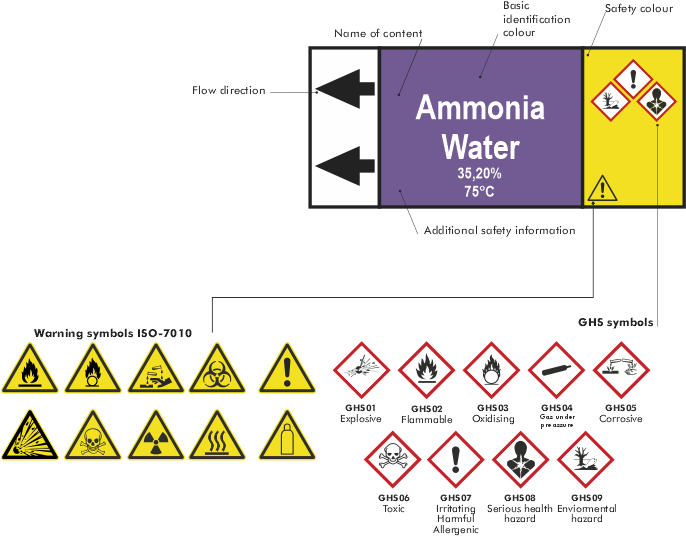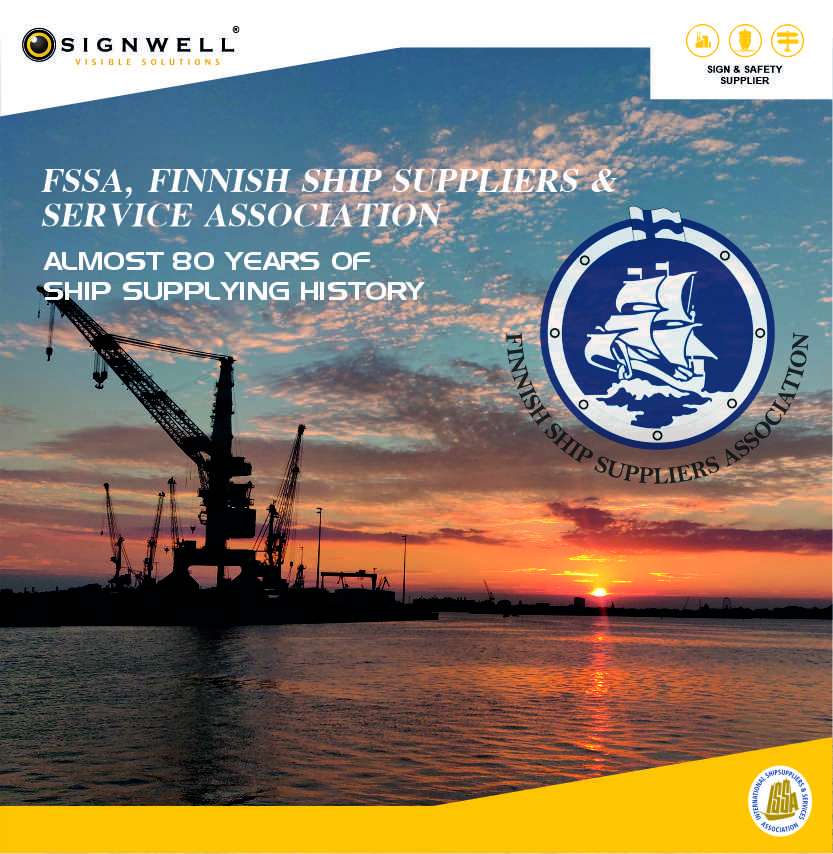
Signwell implements the 3L-EP™, EP LLL onboard Mein Schiff 7
Mein Schiff 7 Signwell has been contracted by Meyer Turku to implement the EP Low Location Lighting System on the latest adding to TUI Cruises, Mein Schiff 7. The…
Read more
The ISO 20560 is a global standard in marking of pipelines and tanks to prevent accidents by informing the contents and the hazardous substances in a harmonized way. This is the very first global standard which creates a unified safety marking system for above ground piping systems and tanks.

Providing a scope of uniformity regarding colour coding for the substances of the pipes (medium colours), ISO 20560-1 consists of the globally harmonized hazard pictograms also known as GHS symbols, additional warning symbols according to ISO 7010, flow direction indications and additional process identification information that is needed. This folds into a uniform pipe marking that will visually include all information needed for the specific pipe lines.
As an extension to ISO 20560-1, the ISO 20560-2 is focused on the marking of tanks. All industrial tanks and vessels carrying hazardous substances must be marked according to legislation and regulations. Combined with elements from ISO 20560-1 such as medium colours, the marking of tanks will be more uniform as a part of the whole ISO 20560 standard.
The ISO 20560-2 standard outlines the use of CLP pictograms, ISO safety symbols, and other important tank markings such as medium designation, tank identification, and tank capacity. Additionally, the standard includes international identification methods for hazardous substances. This may involve incorporating the NFPA hazard diamond, GeVi (Hazard Identification Number), and UN substance number to provide emergency services with essential information regarding the contents and properties of the substances stored in the tank.
The purpose of ISO 20560 is to facilitate the dissemination of information in a consistent and standardized manner to an expanding and mobile user population. The escalating number of workers involved in piping systems and tanks that may contain hazardous substances has highlighted the need for a standardized safety information system. Recognized visual communication tools, such as pipe and tank markings, play an essential role in preventing errors and incidents while enhancing efficiency. To meet this objective, ISO has established guidelines and standards.
There has existed various national as well as international standards for the marking of piping systems and tanks, yet there was no single, coherent system.
The reason of ISO 20560 standard is to establish a uniform system and procedures for the labelling of pipe lines and tanks across all types of facilities. The aim is to ensure the consistency and comprehensibility of hazard identification within manufacturing premises that comply with ISO 20560. This will facilitate clear communication of information to both permanent employees, external service providers, and emergency services. As a summary to this, we can conclude that using one standard will contribute to improved occupational safety meanwhile it will reduce the risk of accidents in a world where we are travelling across our boarders, visiting, maintaining and overall working in different industrial facilities.

Are you interested in implementing pipe markings according to ISO 20560-1 and or marking your tanks according to ISO 20560-2 standard? Signwell takes care of the entire process. Everything from planning to realisation of pipe marking. Our team will do the engineering and layout and produce the pipe markings in our production facilities, in order for us to adequately realise your deliveries and projects. We produce the markings by appropriate quality requirements, to endure the environment and desired life span of the pipe markings. Our installation teams specialized in marking pipes, will take care of the implementation, and make sure that the pipe markings are placed visibly and accordingly.

Mein Schiff 7 Signwell has been contracted by Meyer Turku to implement the EP Low Location Lighting System on the latest adding to TUI Cruises, Mein Schiff 7. The…
Read more

The Finnish Ship Suppliers & Service Association, FSSA has undertaken innumerable actions to defend the interest of the maritime supply sector in Finland, the Baltic Sea and worldwide for almost…
Read more
Signwell has been contracted by Meyer Turku to supply and realize The New Generation of PL Low Location Lighting System on the latest adding to Royal Caribbean Cruise Line (RCCL), ICON…
Read more